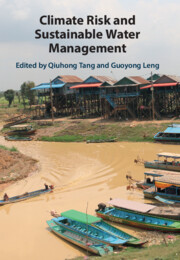Book contents
- Climate Risk and Sustainable Water Management
- Climate Risk and Sustainable Water Management
- Copyright page
- Contents
- Contributors
- Preface
- Acknowledgements
- Part I Water-Related Risks under Climate Change
- 1 Pluvial, Fluvial and Coastal Flood Risks and Sustainable Flood Management in the Pearl River Delta under Climate Change
- 2 Flooding Risk in the Lancang-Mekong River Basin under Global Change
- 3 Spatial Drought Patterns in East Africa
- 4 Assessment of Global Water Erosion Vulnerability under Climate Change
- 5 Water Erosion and Its Controlling Factors in the Anthropocene
- 6 Climate Change Impacts on Saltwater Intrusion into Coastal Aquifers
- Part II Climate Risk to Human and Natural Systems
- Part III Sustainable Water Management under Future Uncertainty
- Index
- References
2 - Flooding Risk in the Lancang-Mekong River Basin under Global Change
from Part I - Water-Related Risks under Climate Change
Published online by Cambridge University Press: 17 March 2022
- Climate Risk and Sustainable Water Management
- Climate Risk and Sustainable Water Management
- Copyright page
- Contents
- Contributors
- Preface
- Acknowledgements
- Part I Water-Related Risks under Climate Change
- 1 Pluvial, Fluvial and Coastal Flood Risks and Sustainable Flood Management in the Pearl River Delta under Climate Change
- 2 Flooding Risk in the Lancang-Mekong River Basin under Global Change
- 3 Spatial Drought Patterns in East Africa
- 4 Assessment of Global Water Erosion Vulnerability under Climate Change
- 5 Water Erosion and Its Controlling Factors in the Anthropocene
- 6 Climate Change Impacts on Saltwater Intrusion into Coastal Aquifers
- Part II Climate Risk to Human and Natural Systems
- Part III Sustainable Water Management under Future Uncertainty
- Index
- References
Summary
The Lancang-Mekong River Basin (LMRB) is Asia's most important transboundary river. The precipitation-dependent agriculture and the world's largest inland fishery in the basin feed more than 70 million people. Floods are the main natural disasters which pose a serious threat to the local agriculture and human life. In the future, climate change will affect the streamflow and lead to changes in flood events. Based on the GMDF and GCM data, the SPI and the VIC model were used to assess the impact of climate change on streamflow and flood events during the historical (1985–2016) and future periods (2020–2050) in the LMRB. The results show that the LMRB will become more humid in the future and annual precipitation will change from about -2 to 6 per cent under RCP4.5 and RCP8.5. In the future, this basin should experience a higher flood risk, with more flood events and a relative increase in the flood peak and frequency reaching up to +15 and +58 per cent, respectively. This study contributes to improve our understanding of the role of climate change on streamflow and flood events and provides a scientific reference for the development of local water resources management in the LMRB.
Keywords
- Type
- Chapter
- Information
- Climate Risk and Sustainable Water Management , pp. 29 - 46Publisher: Cambridge University PressPrint publication year: 2022

